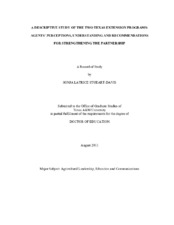| dc.contributor.advisor | Elbert, Chanda | |
| dc.contributor.advisor | Lawver, David | |
| dc.creator | Stueart-Davis, Sonja Latrice | |
| dc.date.accessioned | 2012-10-19T15:28:42Z | |
| dc.date.accessioned | 2012-10-22T17:59:23Z | |
| dc.date.available | 2012-10-19T15:28:42Z | |
| dc.date.available | 2012-10-22T17:59:23Z | |
| dc.date.created | 2011-08 | |
| dc.date.issued | 2012-10-19 | |
| dc.date.submitted | August 2011 | |
| dc.identifier.uri | https://hdl.handle.net/1969.1/ETD-TAMU-2011-08-9756 | |
| dc.description.abstract | Texas is one of 17 states with both 1862 and 1890 Extension programs. The purpose of this study was to examine the partnership amongst agents of Texas AgriLife Extension Service and the Cooperative Extension Program, in counties that have both Extension programs. Seventy-eight agents participated in the study, of which, 73% (N=57) were employed by Texas AgriLife Extension Service and 24% (N=19) were employed by the Cooperative Extension Program. Cohen's D Effect Size was used to determine the practical significance of differences among agents' perception of the relevance of Texas AgriLife Extension Service, Cooperative Extension Program at Prairie View A&M University, along with the agents' understanding of the partnership, willingness to partner and knowledge of the Operational Guidelines. As part of the study, agents also identified strengths, weaknesses, and opportunities of having two programs in the State and provided recommendations for strengthening the partnership. Among agents, there was a high degree of relevance for Texas AgriLife Extension Service, while there was a moderate degree of relevance for the Cooperative Extension Program-Prairie View A&M. Cohen's D Effect size suggested a large practical difference amongst agents in their perception of both Extension programs. Findings indicated a moderate degree of knowledge of the Operational Guidelines and understanding of the partnership amongst agents. Cohen's D Effect size value (d =.1.29) and (d =1.30) suggested a large practical differences amongst agents, from the two programs, in relation to their willingness to partner and understanding of the partnership respectively. Strengths of having two Extension programs identified by agents were the Extension programs ability to reach new and diverse audiences and address community and state needs. Weaknesses identified were agents competing against one another for audiences, two programs causing confusion to clientele, and a lack of understanding on how to collaborate. Opportunities of having two Extension programs identified were collaborating on programs, reaching diverse audiences, and the ability to provide more services. Agents provided recommendations of better communication to understanding the partnership and how to partner, clearer job descriptions to prevent duplication and competition, and making the citizens the priority instead of the Extension programs. | en |
| dc.format.mimetype | application/pdf | |
| dc.language.iso | en_US | |
| dc.subject | Texas Extension | en |
| dc.subject | Texas AgriLife Extension Service | en |
| dc.subject | Cooperative Extension Program-Prairie View A & M | en |
| dc.subject | partnerships | en |
| dc.subject | perceptions | en |
| dc.title | A Descriptive Study of the Two Texas Extension Programs: Agents’ Perceptions, Understanding and Recommendations for Strengthening the Partnership | en |
| dc.type | Thesis | en |
| thesis.degree.department | Agricultural Leadership, Education, and Communications | en |
| thesis.degree.discipline | Agricultural Leadership, Education, and Communications | en |
| thesis.degree.grantor | Texas A&M University | en |
| thesis.degree.name | Doctor of Education | en |
| thesis.degree.level | Doctoral | en |
| dc.contributor.committeeMember | Larke, Alvin | |
| dc.contributor.committeeMember | Burris, Scott | |
| dc.type.genre | thesis | en |
| dc.type.material | text | en |


